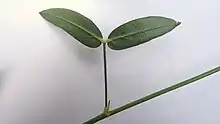Zornia latifolia
Zornia latifolia is a species of flowering plant in the legume family, Fabaceae. It is native to South America.[1] Its distribution may extend into Central and North America.[3] It is also known as a naturalized species in tropical western Africa.[1] The plant is known commonly as maconha brava.[4]
| Zornia latifolia | |
|---|---|
 | |
| Scientific classification | |
| Kingdom: | Plantae |
| Clade: | Tracheophytes |
| Clade: | Angiosperms |
| Clade: | Eudicots |
| Clade: | Rosids |
| Order: | Fabales |
| Family: | Fabaceae |
| Subfamily: | Faboideae |
| Genus: | Zornia |
| Species: | Z. latifolia |
| Binomial name | |
| Zornia latifolia | |
| Synonyms[2] | |
| |
Description
This plant is a perennial herb with a branching stem taking a prostrate form on the ground and growing up to about 50 centimeters long. The leaves are bifoliolate, each made up of two leaflets, which are widely lance-shaped and up to 4 centimeters long. At the base is a stipule up to a centimeter in length. The herbage is hairless to lightly hairy. The inflorescence is a spike of up to 35 yellow flowers each about a centimeter long. The flowers open for only 5 to 10 hours. The bractlets are longer than the flowers and may cover them. The fruit is a spiny, hairy legume pod.[5]
Ecology
In its native range it grows in savanna habitat with acidic and low-fertility soils. It tolerates drought, but does not tolerate cold or shade.[5] In Africa it grows as a weed in lawns and on roadsides.[3]
The plant is susceptible to plant pathogens such as the fungi Sphaceloma zorniae, which causes scab disease, and Meliola species, which cause stunting and distortion of the leaves. Insect pests include the red-necked peanutworm moth (Stegasta bosqueella).[5]
Uses
Forage
This legume is a nutritious and palatable forage for livestock. It can be grown as a companion plant to grasses such as Andropogon gayanus and Brachiaria decumbens.[5]
Hallucinogen and adulteration
A common component of many synthetic cannabis mixtures producing hallucinogenic effects, such as the street drug, 'Spice', though these mixtures effects are caused by synthetic cannaboids, Zornia latifolia may have cannabis-like effects.[6][7] It may be adulterated by a different Fabaceae plant, Stylosanthes guianensis, which is phytochemically different from Zornia latifolia.[6] The flavones genistein and apigenin may explain the cannabis-like effects of Zornia latifolia.[6]
References
- "Zornia latifolia". Germplasm Resources Information Network. Agricultural Research Service, United States Department of Agriculture. Retrieved 21 January 2018.
- Zornia latifolia. The Plant List.
- Zornia latifolia. FAO.
- Fattore, L. and W. Fratta. (2011). Beyond THC: the new generation of cannabinoid designer drugs. Frontiers in Behavioral Neuroscience 5, 60.
- Zornia latifolia. TropicalForages.
- Cornara, L.; Fortuna-Perez, A. P.; Bruni, I.; Salis, A.; Damonte, G.; Borghesi, B.; Clericuzio, M. (2018-09-01). "Zornia latifolia: a smart drug being adulterated by Stylosanthes guianensis". International Journal of Legal Medicine. 132 (5): 1321–1331. doi:10.1007/s00414-018-1774-z. hdl:11449/164509. ISSN 1437-1596. PMID 29362872. S2CID 12630518.
- Fattore, Liana; Fratta, Walter (2011). "Beyond THC: The New Generation of Cannabinoid Designer Drugs". Frontiers in Behavioral Neuroscience. 5: 60. doi:10.3389/fnbeh.2011.00060. ISSN 1662-5153. PMC 3187647. PMID 22007163.
![]() Media related to Zornia latifolia at Wikimedia Commons
Media related to Zornia latifolia at Wikimedia Commons